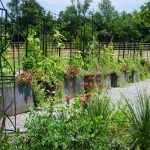
Whether you have a large apartment complex or a tiny loft, a roof top garden is a great way to enjoy nature without the need for a backyard. Depending on the size and type of roof, you may need to invest in a wall or fencing to provide support. Also, building codes may have height requirements for the structure, so you’ll want to consider a barrier for kids or pets. In addition, if your garden is in full view of your neighbors, consider adding screens, such as vines or evergreen hedges. An umbrella table may be useful for a relaxing break.
Before you begin planting your plants on your roof, make sure you check with local building codes to determine if you’re allowed to do so. While many buildings don’t allow plants on shared roofs, some building owners will allow you to grow plants as long as they are not invasive. Additionally, some homeowners associations require you to adhere to a certain height limit and aesthetics code. Once you’ve gathered these facts, you’re ready to start planning your rooftop garden.
You’ll soon be able to enjoy your rooftop garden. It’s a peaceful place in the heart of the city. It’s also a great place for a social gathering. Even if you don’t live in a condo or an apartment complex, you can still grow beautiful plants in the space. And you can grow them in containers and pots to enjoy for years. And if you have a balcony or a patio, you can plant a variety of flowers or herbs to add to your greenery.
Rooftop gardens are great for aesthetic reasons, but they require proper maintenance. You should avoid using peat-based growing medium, which dries out too quickly. Instead, use chunk coir-peat growing media and supplement it with clay aggregates. For extra protection, check with a professional and ask them to recommend a growing media with added porosity to help your plants grow long-term. There are several different types of growing media available, but they all have their advantages and disadvantages.
Depending on the space available, a rooftop garden can be highly customized. You can plant plants in buckets, custom-built raised beds, and even use a combination of both. Make sure to make sure your rooftop garden has proper drainage, as improper drainage can lead to root rot. You should also choose plastic or wooden containers, as these are much lighter than concrete or wood. A roof top garden should be maintained regularly with the right soil and care.
In addition to growing food, a roof garden can be a place to meet and interact with your neighbors. Whether you own a home with rooftop space, or share a space, a garden can bring people together and make the building more liveable. Even a few potted plants can make an otherwise barren space come alive. If you are planning to plant a garden on the roof of your apartment, you can even buy solar lanterns, deck chairs, and picnic tables to create an oasis that everyone can enjoy







